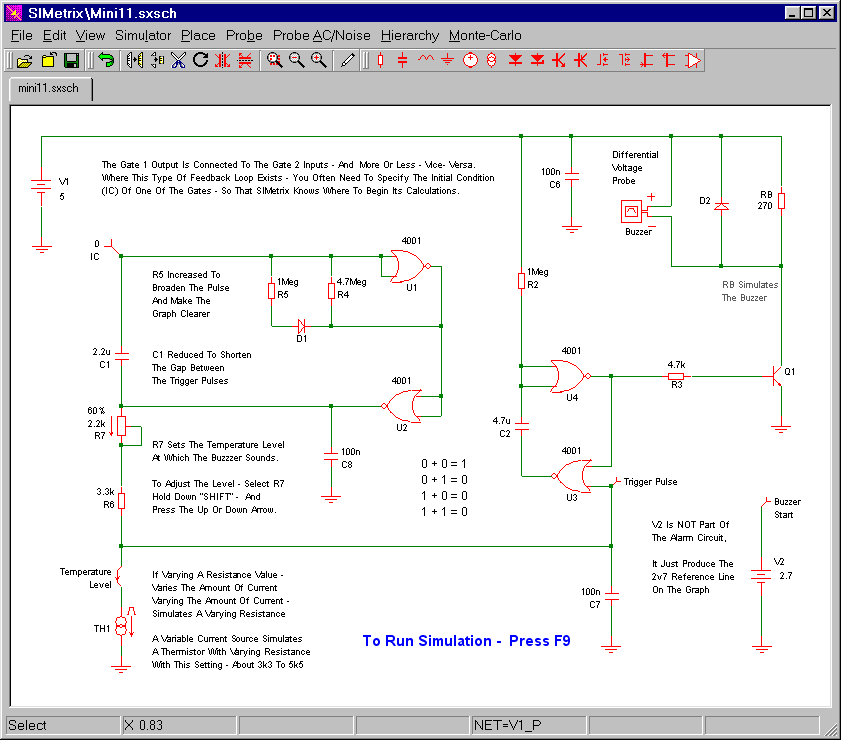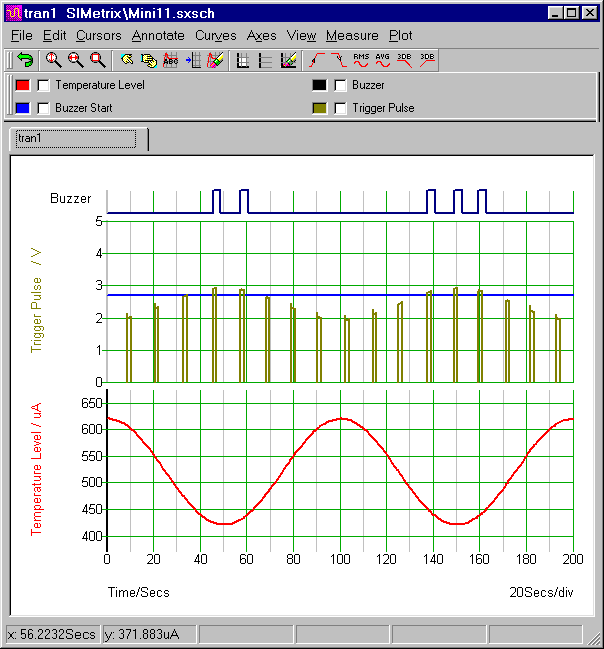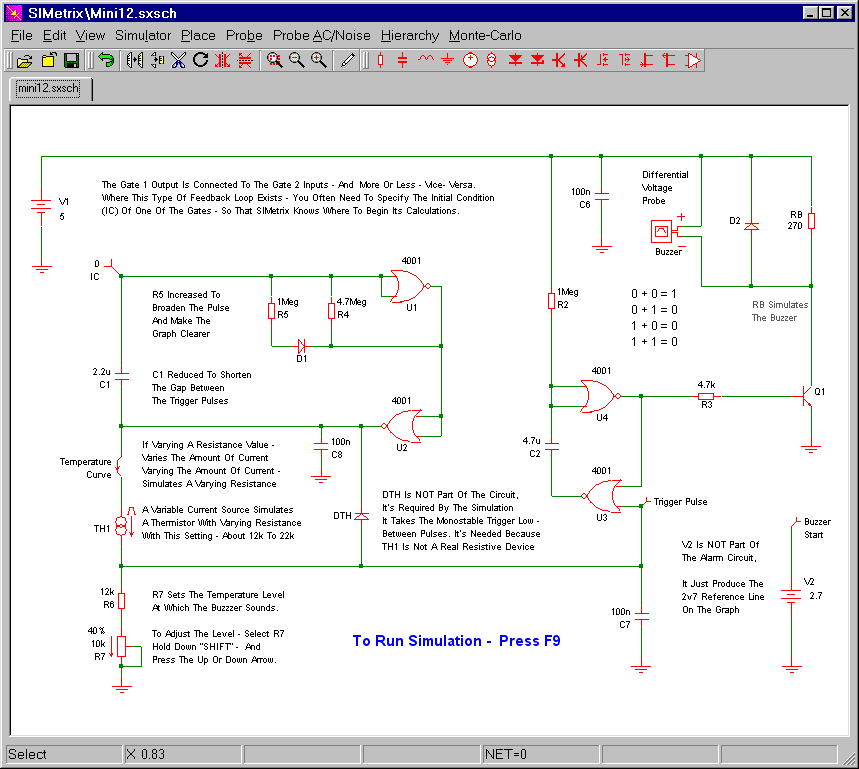You can use the free
SIMetrix Circuit Simulator to run
My Simulations. Or you can use my observations, tips and techniques - to help you create a suitable file for a different simulator programme. If you do decide to create your own simulation - it may still be worthwhile to download SIMetrix and run my simulations for comparison.
Circuit No.11
This circuit uses a small piezo buzzer. But you can also connect the coil of a small relay to the buzzer terminals. I've used a 270 ohm resistor (RB) to simulate my buzzer and/or relay coil. The differential voltage probe measures the voltage across the resistor. And the state of the buzzer / relay - is determined by the level of that voltage.

Mini-Alarms 11 & 12
In the graph below - the red curve represents a rising and falling temperature. With the component values shown in the diagram - the variation is roughly between 20°C and 30°C. That's about 68°F to 86°F. As the temperature falls - the height of the trigger pulse rises. And as the temperature rises - the height of the trigger pulse falls. If the temperature falls far enough for the pulse to cross the horizontal blue line - the monostable will trigger - and sound the buzzer for about 3 seconds. The length of time the buzzer sounds - is controlled by the values of R2 & C2.
Circuit No.11 - Graphs

Mini-Alarms 11 & 12
R7 sets the temperature level at which the buzzer will begin to sound. Increasing the value of R7 - tends to reduce the height of the trigger pulses. So the temperature will have to fall further - before the pulse is tall enough to sound the buzzer. Similarly - decreasing R7 tends to increase the height of the trigger pulses. So a smaller fall in temperature will sound the buzzer.
To simulate a change to the temperature setting - select R7 - hold down the "shift" key - and press either the "up" or the "down" arrow. If you reduce the value of R7 to 0% - all of the pulses will cross the line - and the buzzer will keep repeating. With R7 set at about 80% - only the peak pulses will cross the line. So the buzzer will only sound while the temperature is at its lowest level. If you set R7 to 100% - none of the pulses will cross the line - because the simulated temperature is never low enough to trip the alarm.
Circuit No.12
This circuit uses a small piezo buzzer. But you can also connect the coil of a small relay to the buzzer terminals. I've used a 270 ohm resistor (RB) to simulate my buzzer and/or relay coil. The differential voltage probe measures the voltage across the resistor. And the state of the buzzer / relay - is determined by the level of that voltage.

Mini-Alarms 11 & 12
In the graph below - the red curve represents a rising and falling temperature. With the component values shown in the diagram - the variation is roughly between -4°C and +6°C. That's about 25°F to 43°F. As the temperature rises - the height of the trigger pulse rises. And as the temperature falls - the height of the trigger pulse falls. If the temperature rises far enough for the pulse to cross the horizontal blue line - the monostable will trigger - and sound the buzzer for about 3 seconds. The length of time the buzzer sounds - is controlled by the values of R2 & C2.
Circuit No.12 - Graphs

Mini-Alarms 11 & 12
R7 sets the temperature level at which the buzzer will begin to sound. Increasing R7 tends to increase the height of the trigger pulses. So a smaller rise in temperature will sound the buzzer. Similarly - decreasing the value of R7 - tends to decrease the height of the trigger pulses. And the temperature will have to rise further - before the pulse is tall enough to sound the buzzer.
To simulate a change to the temperature setting - select R7 - hold down the "shift" key - and press either the "up" or the "down" arrow. If you increase the value of R7 to 100% - all of the pulses will cross the line - and the buzzer will keep repeating. With R7 set to 20% - only the peak pulses will cross the line. So the buzzer will only sound while the temperature is at its highest level. If you set R7 to 0% - none of the pulses will cross the line - because the simulated temperature is never high enough to trip the alarm.
Why Are The Simulations 5-Volts?
The Cmos Models that come with SIMetrix 5.40 are designed for a 5-volt supply. And, to keep matters simple, I've set up a 5-volt simulation. However - the alarm itself is designed to work over a range of supply voltages. So included in the
Download Material - you'll also find 9v and 12v simulations. To run these additional simulations successfully - you'll need to install my 9v & 12v Cmos models. This is very easy. Simply drag and drop the "MyMods.lb" file into the small "SIMetrix Command Shell" window. And - when asked - confirm that you want to install the new models. Don't Worry! You're not overwriting anything. All the existing models are still there.